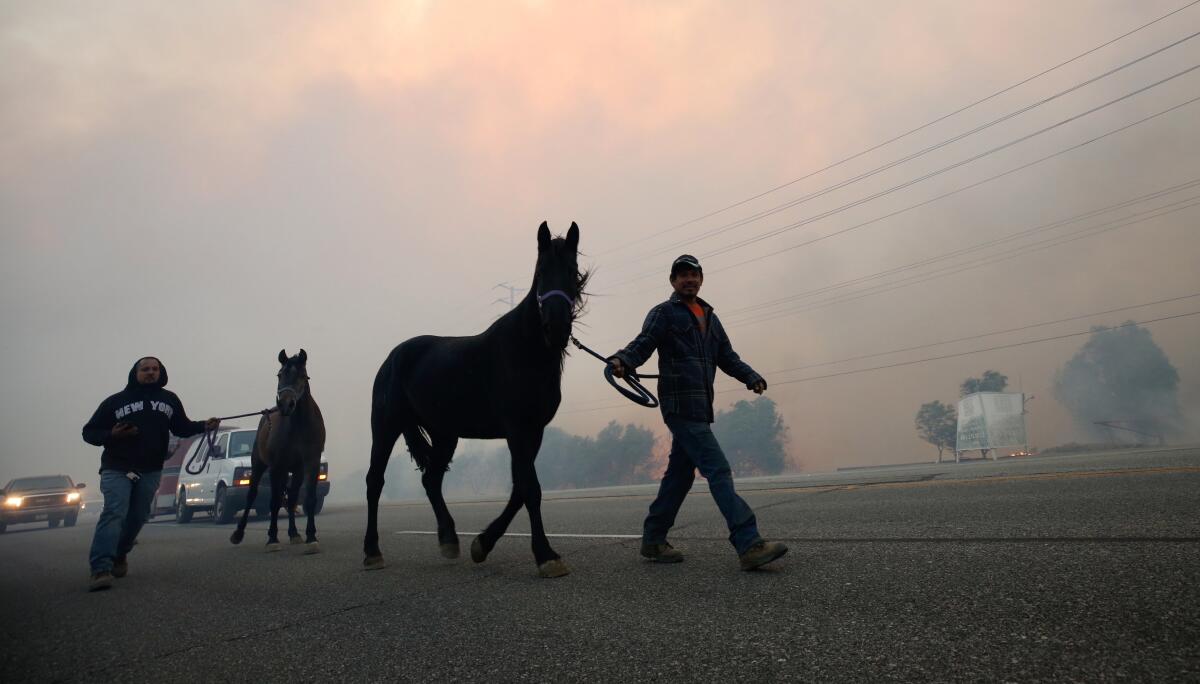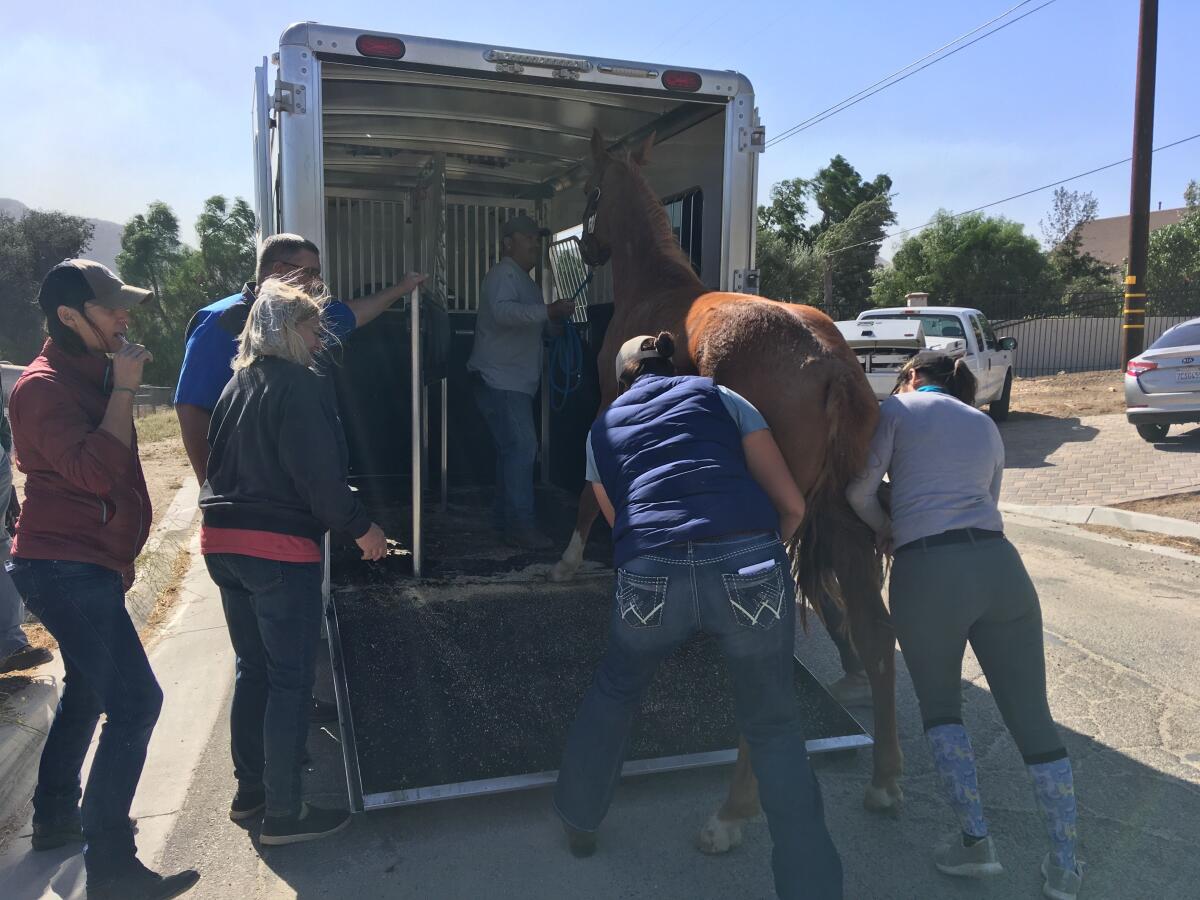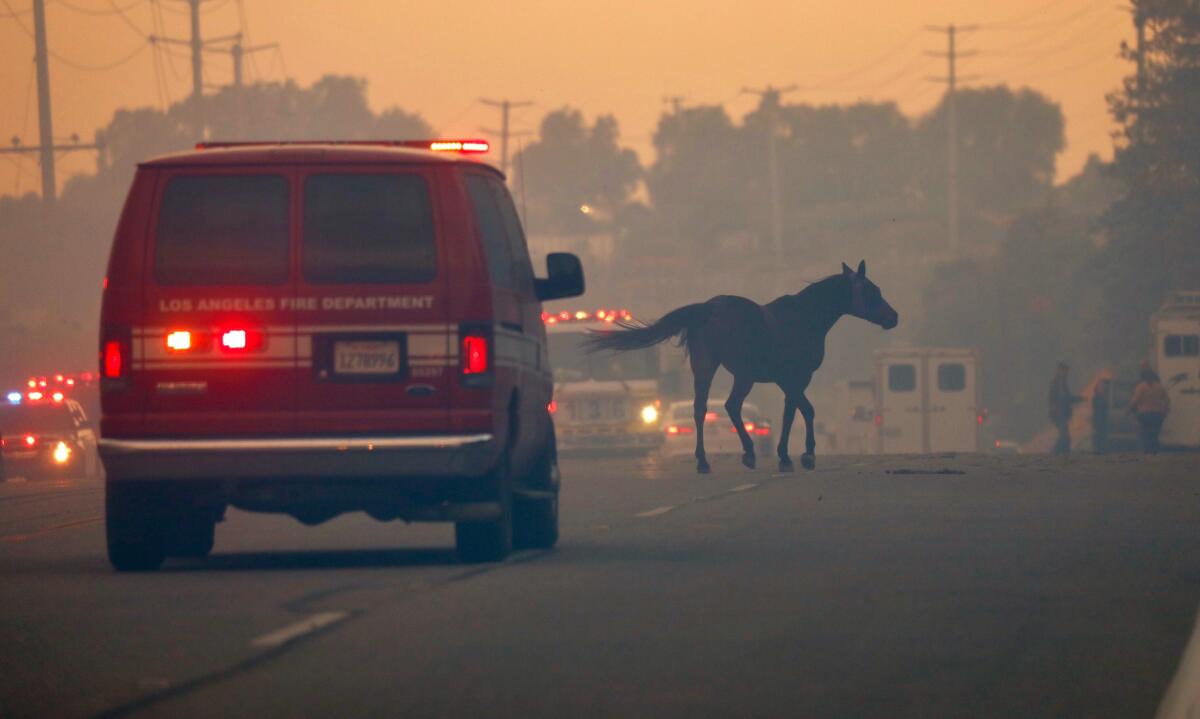San Juan Capistrano-based team rescues horses from wildfires and other disasters

- Share via
As the Easy fire burned in Simi Valley last month, images of frightened horses running between a column of evacuating vehicles gripped animal lovers nationwide.
When flames threatened a barn, volunteers moved the equines to safety. All but one escaped the blaze; a 28-year-old mare broke her front legs and was euthanized, according to reports.
Equestrians answer calls for help
Throughout Orange County, volunteers offer to help during disasters by towing their horse trailers into evacuation zones after reading pleas for help on social media and group chats.
“We’ve had such a good history of equestrians helping other equestrians,” said Julie Ryan Johnson, a veterinarian and board member of the San Juan Equestrian Coalition. “These are beautiful creatures that are scared and at-risk and people want to help.”
San Juan Capistrano established the Large Animals Response Team (LART) in 2008 to assist the city’s Community Emergency Response Team. The program expanded and now has members in nearly 40 cities in Orange and Riverside counties. They’re prepared to rescue horses, ponies, donkeys, pigs, goats, sheep, cattle, llamas, alpacas and large tortoises.
Volunteers are trained by Johnson and Lynn Mata, the emergency services manager for San Juan Capistrano.

LART activated for the Holy fire that burned in and around Trabuco Canyon in August 2018, requiring 21,400 evacuations at its peak.
LART is part of Orange County’s incident command system that coordinates disaster response by municipal, regional, state and federal agencies. This means the incident commander for a wildfire must put in an official request with San Juan Capistrano’s administration before volunteers can pull trailers into evacuation zones.
“We are not a horse ambulance or a horse Uber service,” Johnson said.
This rigid structure frustrates equestrians who believe preserving animals’ lives supersedes protocol and has pushed some to tow trailers into evacuation zones without permission or insurance
Good deeds may compromise safety
Emergency management professionals fear ad hoc rescues, while made with good intentions, can needlessly put the public and first responders in harm’s way. Horse trailers could potentially block ingress and egress for fire apparatus.
“You can send a big trailer but then it can’t turn around,” Johnson said. “You need to know the terrain.”
LART keeps a list of trailers owned by its members and tailors convoys based on a given neighborhood’s animal population and accessibility, Johnson said.
San Juan Capistrano, an equestrian-friendly city with about 35,000 residents, has arguably taken on an outsized role.
While city staffers and volunteers are eager to come to the aid of disaster-plagued communities, OC Animal Care is better-equipped to take on countywide rescue efforts, Mata said.
Los Angeles County Dept. of Animal Care and Control has three full-time supervisors monitoring emergency response, department spokesman Don Belton said.
The San Diego Humane Society operates an emergency response team of trained volunteers who work with law enforcement to safely rescue horses, livestock and pets.
“We’ve had very preliminary conversations at the staff level involving the future of LART and the optimal structure to provide countywide emergency response,” Mata said in a prepared statement. “We value our partnership with the County and look forward to continued discussions.”

Emergency management staffers with the Orange County Sheriff’s Department are engaged in discussions about LART’s future and do not object to OC Animal Care taking over the program, the department’s Carrie Braun said.
OC Animal Care has discussed the future of LART with other agencies but has not introduced a formal proposal, department spokeswoman Jessica Novillo wrote in an email.
A represenative for Board of Supervisors Chairwoman Lisa Bartlett said her office is examining the matter.
LART would be able to activate quickly and correctly, said Johnson, a member of an ad hoc group of county, city, nonprofit and volunteer organizations statewide examining best practices for large animal rescues.
“You’re putting a lot on San Juan [Capistrano] to help the whole county,” Johnson said. “It’s been requested many, many times. It falls off everyone’s agenda.”
Preparation is key, advocates say
Community members will often arrange for their animals to be transported before a deployment order comes down from the county for LART, equestrians say.
Dee Dee Friedrich, a LART member and president of Yorba Linda Country Riders, said horse owners rode down Chapman Avenue from Orange Park Acres during the Canyon 2 fire in October 2017 because there weren’t enough trailers to go around.
“If San Juan [Capistrano] is not going to be our county LART program, then I think it’s definitely time for someone to step up to the plate,” Friedrich said. “Someone needs to step up, because look at Paradise, look at Irvine Regional Park two years ago.”
LART also teaches horse owners how to prepare for and safely evacuate a disaster zone, Mata said.
“The principle we teach is how to help yourself and help your neighbors,” she said. “Residents should have several evacuation routes in mind and, if you don’t have your own truck and trailer, make arrangements with local companies or neighbors before disaster strikes.”
It’s critical for animal owners to keep easily accessible neighbors’ contact information, vaccination/medical records, registration papers and photographs of their animals, as well as a disaster-preparedness kit for their animals, Mata said.
“I would much rather people call on their friends than sit around and wait for something to happen,” she said.
All the latest on Orange County from Orange County.
Get our free TimesOC newsletter.
You may occasionally receive promotional content from the Daily Pilot.




